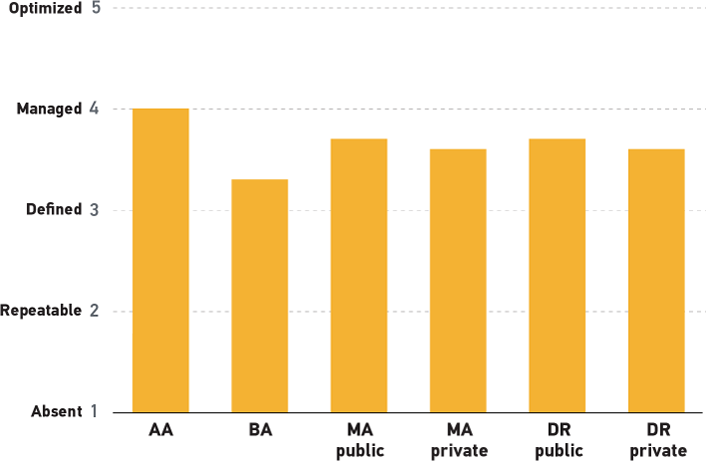The focus of higher education's COVID-19 adaptations is on remote learning and working. Advising systems, degree progress tracking, and other technologies to support student success will be equally critical to help students complete courses and attain credentials.

The COVID-19 pandemic is prompting many colleges and universities to abruptly and comprehensively adopt online learning, remote work, and other activities to help contain the spread of the virus. In the past decade, institutions have recognized the importance of advising, early alerts, degree planning, and other services to help students attain their academic goals affordably and efficiently. A wide range of new applications and technologies to support student success are now available and may prove invaluable to help students adapt to fully remote learning. EDUCAUSE data from 2019 reveal that many, but far from all, institutions, students, faculty, and staff are ready and able to use these technologies during the pandemic.1
This research summary is one of a series of reports outlining higher education's readiness to adapt in response to the COVID-19 pandemic.
How Many Institutions Are Using Technology to Support Student Success?
Core technologies that support student success include advising center management (which is deployed partially or institution-wide at 76% of institutions) and an advising case management system that tracks student interactions (70% partial or institution-wide deployment).
Other data and analytics technologies and practices support managing, sharing, and decision-making related to student success. Table 1 shows technologies that support student success, which are in place in at most half of institutions. Technologies that allow students to opt in or out of data collection or analytics are still uncommon (in place at only 28% of institutions).
Table 1. Student success data and analytics technology and practice adoption
|
Student Success Data and Analytics Technology |
Percentage of Institutions with This in Place |
|---|---|
|
Student success data warehouse/operational data store |
50% |
|
Student success analytics dashboards |
49% |
|
Student success analytics system (i.e., predictive modeling) |
41% |
|
Consent platform for students to opt in/out of data collection/analytics |
28% |
Table 2 lists best practices related to student success data management and governance. Although policies and practices to safeguard data are widespread (in place at 78% of institutions), fewer institutions report having the data they need and sharing data across systems. This suggests that even though most institutions have the core technologies and policies in place, they still have significant progress to make in accessing and integrating needed data.
Table 2. Student success data and analytics best practices
|
Best Practice |
Percentage of Institutions with This in Place |
|---|---|
|
Our institution develops and maintains policies and practices that are sufficiently robust to safeguard data, both institutional and student-level, used for student success analytics (e.g., specification of privileges and responsibilities for data access and storage, ethics of data use). |
78% |
|
Our institution has the right kinds of data to support our student success outcomes and analytics needs. |
58% |
|
Our institution effectively shares data related to student success among technology systems (e.g., SIS, LMS, advising, analytics). |
50% |
Some types of institutions are more prepared—or less prepared—than others to use technology to support student success. Figure 1 compares student success technology maturity (i.e., the extent to which an institution has incorporated EDUCAUSE's recommended student success technology best practices) by Carnegie class. Bachelor's institutions, which typically place the strongest emphasis on campus-based learning, are least ready to use data and technology to support student success, while associate's institutions, which generally adopt learning and instructional technologies more rapidly, are the most prepared.

Are Faculty, Staff, and Students Able to Use Technology to Support Student Success?
Having technologies and analytics is one step. Providing students, faculty, and staff with the access and training to use these systems is a critical additional step. More than half of institutions take steps to facilitate the adoption and use of student success technologies by faculty, advisors, and other staff (see table 3). Six in ten institutions provide applications that enable students to access data such as current academic standing and resources including tips for improvement. Students at institutions that don't provide such access might struggle to track their progress during times when it's difficult to get such feedback, and faculty, advisors, and other staff may lack sufficient training or even access to use tools to help students.
Table 3. Best practices in place to support faculty, advisors, and staff use of student success technologies
|
Best Practice |
Percentage of Institutions with Practice in Place |
|---|---|
|
Our institution supports advisors' adoption and use of information systems that support student success (e.g., early alerts, advising systems, degree progress tracking). |
78% |
|
Our institution supports faculty's adoption and use of information systems that support student success (e.g., early alerts, advising systems, degree progress tracking). |
66% |
|
Application for students to access their data (e.g., current academic standing, tips for improvement, resources) |
60% |
|
Our institution provides training for faculty and advisors to make effective use of student technology systems on an ongoing basis (e.g., continued training, updates). |
57% |
|
Our institution provides tools (e.g., dashboards, portals) to ensure that appropriate staff can create reports and communicate the status of student success metrics and initiatives in a timely manner. |
54% |
Do Institutions Have Technology to Help Students with Credential Planning?
Students need to develop, monitor, and adjust their academic plans to ensure they are on track to attain the credentials they seek as expeditiously as possible; sometimes that entails managing academic credits across multiple institutions. This need may be even more pressing given the current disruption and uncertainty brought on by the pandemic. Fortunately, most institutions have a core set of applications to help students plan their educational programs and manage credits, even across institutions. However, fewer than half of institutions have technologies that can recommend courses or degree programs for students based on their academic record or other factors. Most students who have used these technologies find them very or extremely useful (see table 4).
Table 4. Institutional availability and students' perceived utility of systems to support degree planning and credit management
|
System |
Percentage of Institutions with System |
Percentage of Students Who Find the System Very or Extremely Useful |
|---|---|---|
|
Degree auditing |
93% |
80% |
|
Credit transfer/articulation system/dual enrollment |
77% |
68% |
|
Education plan creation/tracking system |
70% |
77% |
|
Course/program recommendation system |
43% |
51% |
What about Technologies to Help When Students Are at Risk?
Even in stable times, students may encounter academic or personal difficulties. The COVID-19 pandemic is upending lives and livelihoods, increasingly the likelihood that large numbers of students will need extra help. In the past decade, technologies to help identify and support students at risk have become increasingly useful and widespread.
Most institutions have systems to identify academic difficulties early and to help students, faculty, and advisors address those difficulties. More than one-third of institutions (39%) also have tools that can refer students to social or community resources for help (see table 5).
Table 5. Deployment of tools to help students at risk
|
Tool |
Percentage of Institutions with System |
|---|---|
|
Academic early-alert system |
73% |
|
Student self-service referral to social/community resources |
39% |
Although tools to support at-risk students are still relatively new, growing numbers of students and faculty who use them are finding them useful.2 In 2019, more than half of students and between 30% and 40% of faculty rated them as very or extremely useful. Fewer than 10% of student users found them not very useful or not at all useful, but as many as one in five faculty saw them this way (see table 6).
Table 6. Students' and faculty rating of tools that support at-risk students
|
Tool/System |
Very or Extremely Useful |
Not Very or Not at All Useful |
||
|---|---|---|---|---|
|
Students |
Faculty |
Students |
Faculty |
|
|
Early-alert systems designed to catch potential academic trouble as soon as possible |
55% |
39% |
8% |
20% |
|
Tools that suggest how to improve performance in a course |
53% |
33% |
9% |
22% |
|
Self-service referral systems to social or community resources |
54% |
Not asked |
7% |
Not asked |
|
Tools that suggest new or different academic resources |
52% |
35% |
8% |
16% |
Technologies to help identify and intervene with students at academic risk or to give students social or community resource referrals are still extremely new. Even so, students in particular appreciate them and might especially need them now.
Institutions that have adopted student success technologies early and deployed them widely have a significant advantage during COVID-19, when digital life is far less constrained than life in the physical world. Students need help completing their academic terms and earning credentials during this extraordinary crisis, and EDUCAUSE data show that student success technologies can provide digital sources of help and support. The COVID-19 pandemic will have many, many lessons for us all; among them will likely be the ways in which student success technologies can help ameliorate students' academic and even personal concerns and the ways in which these systems and data can be improved to better help students and those who support them when a new normal has established itself.
EDUCAUSE will continue to monitor higher education and technology related issues during the course of the COVID-19 pandemic. For additional resources, please visit the EDUCAUSE COVID-19 web page.
For more information and analysis about higher education IT research and data, please visit the EDUCAUSE Review Data Bytes blog as well as the EDUCAUSE Center for Analysis and Research.
Notes
- This report is based on three data sources: the 2019 study of faculty and technology, the 2019 study of undergraduate students and technology, and the 2019 Core Data Service survey. ↩
- Comparing the 2017 student and faculty surveys with the 2019 data, more students and faculty find the tools useful, and fewer find them not useful. ↩
Susan Grajek is Vice President of Communities and Research at EDUCAUSE.
D. Christopher Brooks is Director of Research at EDUCAUSE.
© 2020 Susan Grajek and D. Christopher Brooks. The text of this work is licensed under a Creative Commons BY-NC-ND 4.0 International License.
